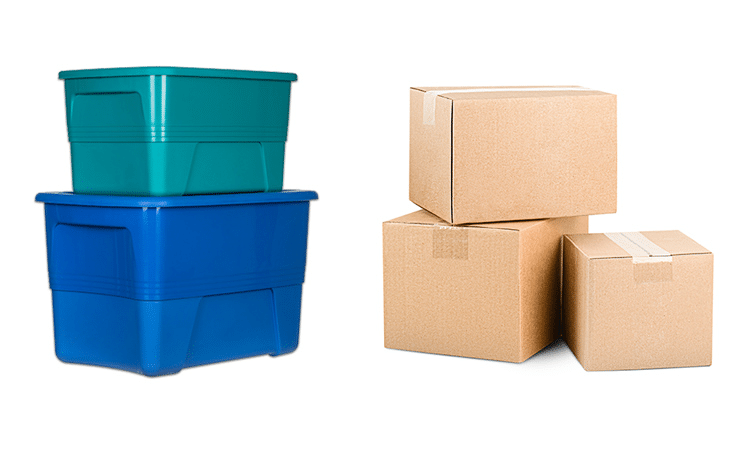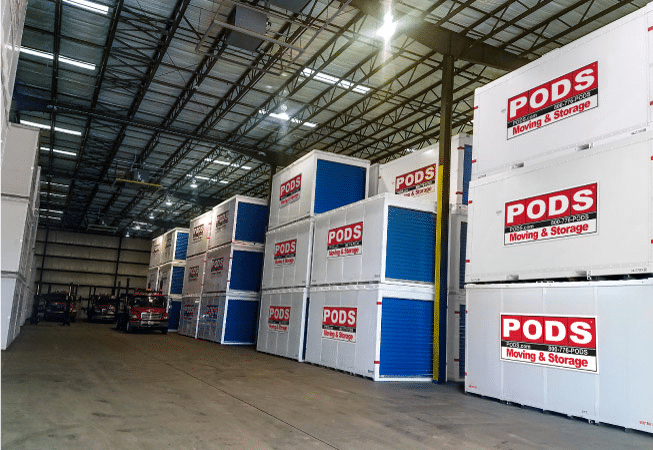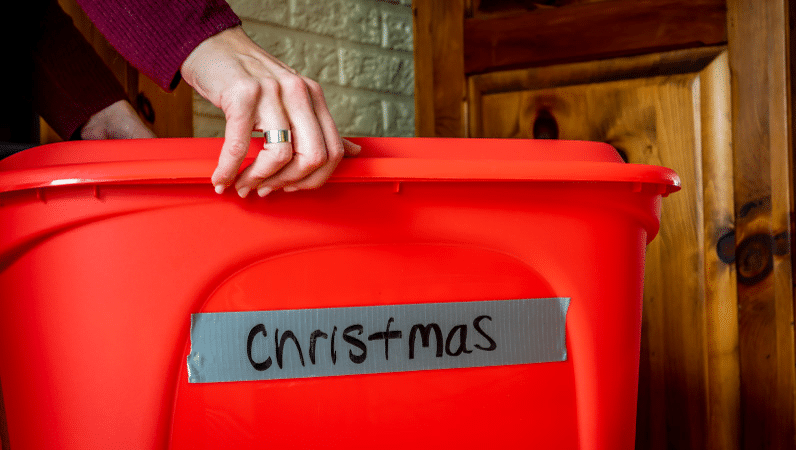
Choosing the Right Kind of Storage Boxes
Storage Tips and Hacks
When you go through the trouble of classifying and storing your belongings, you want to ensure the items stay dry and damage-free, right? While keeping things in good condition depends a great deal on where you’ll be storing them, choosing the right storage boxes makes a big difference, too.
Here are some quick tips on the factors to consider when choosing the perfect containers and storage boxes for your needs.
Match the Storage Container to Its Intended Use
Before you choose a container for storing your belongings, you’ll want to consider these factors:
- What will you be storing?
Are the items fragile or easily broken? Will the contents easily absorb odors? How valuable are these items?
- Where will you be storing this stuff?
Will you be storing it inside your home in a closet where your stuff will stay cool and dry or inside your garage or attic, where it might be exposed to high temps and humidity? Do you plan to use an indoor storage unit, which can offer good protection against the elements?
- How long will you be storing everything?
Will this be temporary storage that’s part of a move or remodeling project or long-term storage?
- How often will you need access to the items?
Will you be using these items occasionally, so you'll need easier access than something used just once a year or less?
Once you’re clear about these factors, you’re ready to consider the different types of storage boxes. While these range in price and quality, it’s important to choose storage boxes or containers that are appropriate for the specific use you'll give them.

Types of Storage Boxes and Containers
If you’ve ever watched an organization show on TV or visited a large home store, you know that the variety of containers available seems endless. Fear not, we’ll guide you through the most important factors you need to consider when purchasing your storage supplies.
Cardboard Boxes
Pros:
- Environmentally friendly because they’re biodegradable
- Widely available, so you can find them everywhere
- Very cost-effective compared with other options
- Extremely lightweight, so they’re easy to move
- Versatile and recyclable because they can be easily repurposed
- Easy to assemble and disassemble, as needed
Cons:
- Not water-resistant, so they need to be protected from the elements
- Less durable than other materials, such as plastic
- Not great for heavy items, as they could break
- Must be opened to see what’s inside, so you’ll need to label them especially well
- Easy for pests and rodents to chew through and get to your items
- Flammable, so they could become fire hazards
- Not very stackable, as they can deform or collapse easily
The most economical and versatile option, cardboard storage boxes are great for moving and will take care of many storage needs, as well. They can also be easily transformed into art projects with kids or toys for cats, to name a few things.
That said, over time, cardboard can get worn out, especially after being pulled in and out of storage and re-taped year after year. If you choose to go with cardboard, make sure you start with quality cardboard storage boxes that are in good shape, so they’ll last longer.
Another downside of this material is that cardboard doesn’t provide much protection from bugs or rodents — something to consider if you’re storing items in a shed, garage, or attic. However, if you’ll be storing the boxes inside a closet or an indoor storage facility, cardboard boxes can be a budget-friendly choice. At least as long as it is for items that you won’t be manipulating daily.
Plastic bins are less likely to break than cardboard boxes, making them great for packing heavy items like books.
Plastic Bins
Pros:
- Very durable, so they can be used for years and years
- Visibility, because they’re available in see-through options, so you can see what’s inside at a glance
- Can handle daily manipulation, so you can use them for frequently used items
- Great for heavy items, so they’re less likely to break — even if you fill them with books
- Pests and rodents are unlikely to chew them up, so your items will be safe
- Can be closed hermetically, if you choose one with a special lid
- Versatile, as they can be used to store things in any room or storage situation
- Water-resistant, so they can protect your items better
- Stackable because they’re more resistant to weight and pressure
- Easy to keep clean because dirt doesn’t stick to them as easily
Cons:
- Costly and usually significantly more expensive than other options
- Not biodegradable, so not great for the planet
- Not breathable, so you need to keep them sealed to avoid moisture buildup and mildew growth over time
While they’re slightly more expensive up front, plastic storage boxes will last for years and provide more protection for fragile items. Plastic storage boxes with lids are also easy to stack, so you can maximize your storage space, and easier to open and close without having to deal with packing tape. This makes them extra handy for items you expect to need access to regularly.
Even if you’re only planning for short-term storage while you’re making a move, plastic storage boxes might be ideal for items you’ll want to keep organized inside boxes in your new home in the future. These can include seasonal decor and clothes, as well as special occasion dinnerware that you only use a couple of times a year.
Specialty boxes are more expensive than standard cardboard boxes and can even cost more than plastic bins.
Specialty Boxes
Pros:
- Specifically made for some delicate items, so you won’t have to deal with things not fitting properly
- Practical because some items are easier to pack and unpack with these
- More protective, as those made for TVs and dinnerware will come with special inserts
- Great for sentimental items, such as family photos and small mementos
Cons:
- More expensive than standard cardboard boxes and even plastic bins
- Not very versatile because they’re manufactured with a very specific purpose
- Hard to recycle because they may have weird shapes
- Not stackable, so they can be harder to store in small spaces
There are specialty boxes you can buy that are made for specific items, like dinnerware, flat-screen TVs, and clothing, and they even make special photo storage boxes! These boxes are great for ensuring your items aren’t damaged, since they come with special inserts to secure things for transport.
If you’re going to store clothing that’s best kept on hangers, consider getting a wardrobe box: a tall vertical box with a built-in bar so you can keep your clothes hanging while the box helps provide some protection from heat and sunlight.
| Q: What boxes are best for storage? A: That depends on what you’ll be storing, where you’ll be storing it, and how long you’ll be keeping your things there. Cardboard boxes are great for short-term storage, but if your stuff will stay tucked away for months (or years), plastic containers are probably a better bet longevity-wise. Q: Is it better to store in cardboard or plastic boxes? A: It depends on how long and where you’ll store the items. If you’re storing long term, plastic is usually more practical for a variety of reasons, including the durability of the material. But cardboard storage boxes are cheaper and environmentally friendly. |

Choosing the Right Type of Storage
Selecting the right type of storage comes down to your personal needs, what types of items you’re storing, and whether you’ll need them on hand or not. Take that into account and remember you can potentially mix and match, as needed, just like with storage box options.
In-Home Storage
If you are storing items that you know you’ll need to access frequently, then opting for in-home storage is a no-brainer. Depending on your living situation and geographical location, this may come at a premium in cost and space availability. However, it is still the most convenient option in this scenario.
Whether you have access to a whole attic or basement (lucky you!) or must get creative with your closet space and the “void” under your bed, it’s all a matter of optimizing what you’re working with and choosing the right supplies for the job.
| Q: How can I hide my storage boxes in my bedroom? A: The best bet is to buy under-bed boxes that often take advantage of underused space. Another good option is to stack them in the empty corners and other unused spaces in your closet. |
PODS Storage Centers
Secure PODS Storage Centers are a great option for items you don’t need to use all the time, but still want the option to have easy access to. They're a hassle-free alternative that stores your items securely inside your personal container, which then goes inside a PODS facility, giving it a double layer of reinforced security.
The best part is that whenever you need to access anything, you just need to call your PODS personal storage team. They will either schedule a visit and have your container waiting for you by the time you arrive, or they’ll deliver it wherever you are. It's flexible and it all depends on what works best for you.
Traditional Self-Storage
Traditional self-storage options are great if you want a larger space and don’t need to have frequent access to your belongings. The cost is very affordable and competitive when compared, but it lacks the convenience factor of in-home storage or PODS Storage Centers.
Climate-Controlled Storage
If you’re storing valuable items, such as antique furniture, expensive clothing, collectibles, or art, then a climate-controlled storage unit may be the top option for you.
These indoor units maintain a controlled and stable environment for your items with a set temperature and moisture control. This means that whatever you’re storing will last much longer in perfect condition (or at least in whatever condition you stored things in).
The disadvantage, of course, is that this option tends to be significantly more expensive than other types of storage, so it won't be a great fit for everyone's budget.
| Q: What can I put in my storage boxes to prevent mold? A: Silica gel packets are your friends against mold and humidity when storing all kinds of things. Make sure no moisture gets inside your boxes before sealing them if they’re airtight, or alternatively, use boxes that allow for airflow. |

Storage Tips
Now that you have chosen your space and your supplies, it’s time to get to work! If it still feels overwhelming, don’t worry, we have you covered with the most important tips you need to consider:
1. Don’t Forget to Label
Make sure you can keep track of what’s in storage with adequate labeling. Trust us, this will make life much easier, whether you're moving or staying put.
Most organization and office supply stores will have labels you can easily attach to plastic bins, or you can use permanent markers to write labels directly on a cardboard or plastic box. Whatever type of labeling you use, make sure you mark the sides and the top of the bin, so you can still read them, even when the bins and boxes are stacked on top of each other.
Labeling your containers will also be much easier if you have a system accounting for how they’re packed — they can’t all be “miscellaneous” boxes, for example. Group similar items together and try to create a balance of weight so boxes aren’t super heavy.
2. Keep an Inventory
It’s a good idea to create a storage inventory on your computer, a smartphone app, or in a good old-fashioned notebook to keep track of what items are where — especially when storing long term. Keeping things organized will not only save you time but can prevent potential damage caused by rifling through items or tripping over boxes.
3. Mix Up Box Sizes
You want to have a mix of container sizes to maximize the space. Extra-large boxes are ideal for bedding or lightweight clothing, since they’ll be easier to lift than an extra-large box filled with heavy books or decor.
4. Place Boxes Strategically
Put the items you’ll need access to first, or more often, toward the entry area. Place the heaviest and largest boxes with non-fragile items on the bottom, like ones filled with books or winter gear. Make sure you have a safe spot for boxes that have fragile items — don’t set anything on top of boxes filled with dishes or other breakables. Also, consider adding a few storage racks, so you can secure fragile boxes on the bottom shelf and still place other containers above them.
If you’re using a storage unit or a portable container, create small paths so you’re able to easily access what you need.
Presto. You’re ready to grab the perfect boxes for your storage needs and have a plan for organizing them. Now, if you need someplace to put those boxes, check out more from the PODS Blog — like our article on choosing the right storage facility.
Ivonne Spinoza is a freelance writer and a frequent contributor to the PODS Blog. Her work has appeared in Matador Network, PBS’ Independent Lens, Remezcla, and The Chicago Tribune, among others. When she’s not snuggling her cats, she’s either Kondo-ing someone’s life or fighting jet lag at some airport.
Related Articles
Comments
Leave a Comment
Your email address will not be published. Required fields are marked *
